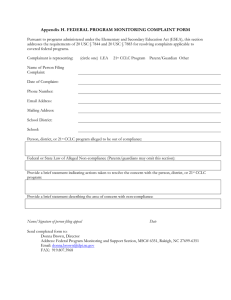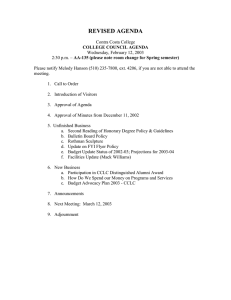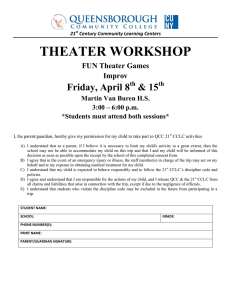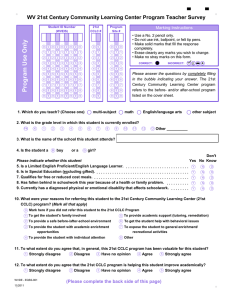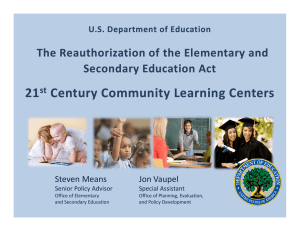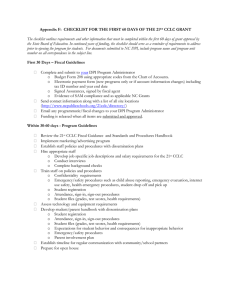fy07report
advertisement
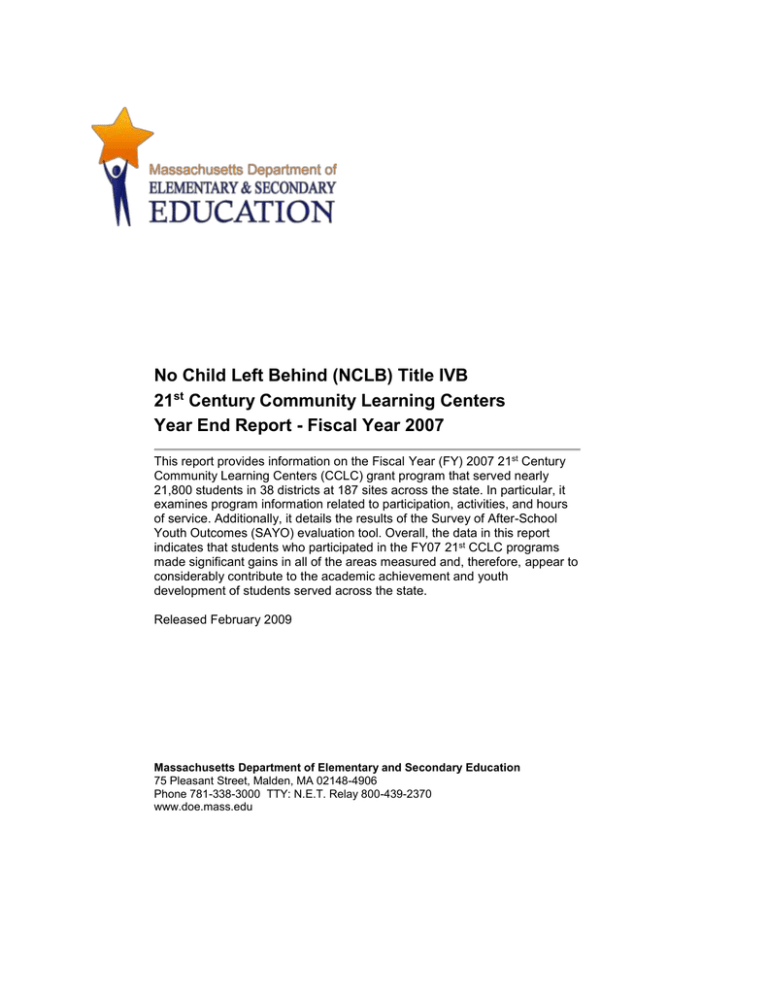
No Child Left Behind (NCLB) Title IVB 21st Century Community Learning Centers Year End Report - Fiscal Year 2007 This report provides information on the Fiscal Year (FY) 2007 21st Century Community Learning Centers (CCLC) grant program that served nearly 21,800 students in 38 districts at 187 sites across the state. In particular, it examines program information related to participation, activities, and hours of service. Additionally, it details the results of the Survey of After-School Youth Outcomes (SAYO) evaluation tool. Overall, the data in this report indicates that students who participated in the FY07 21st CCLC programs made significant gains in all of the areas measured and, therefore, appear to considerably contribute to the academic achievement and youth development of students served across the state. Released February 2009 Massachusetts Department of Elementary and Secondary Education 75 Pleasant Street, Malden, MA 02148-4906 Phone 781-338-3000 TTY: N.E.T. Relay 800-439-2370 www.doe.mass.edu This document was prepared by the Massachusetts Department of Elementary and Secondary Education Mitchell D. Chester, Ed.D Commissioner Board of Elementary and Secondary Education Members Ms. Maura Banta, Chair, Melrose Ms. Harneen Chernow, Jamaica Plain Mr. Gerald Chertavian, Cambridge Mr. Andrew “AJ” Fajnzylber, Chair, Student Advisory Council, Brookline Dr. Thomas E. Fortmann, Lexington Ms. Beverly Holmes, Springfield Dr. Jeff Howard, Reading Ms. Ruth Kaplan, Brookline Dr. Dana Mohler-Faria, Bridgewater Mr. Paul Reville, Secretary of Education, Worcester Dr. Sandra L. Stotsky, Brookline Mitchell D. Chester, Ed.D., Commissioner and Secretary to the Board The Massachusetts Department of Elementary and Secondary Education, an affirmative action employer, is committed to ensuring that all of its programs and facilities are accessible to all members of the public. We do not discriminate on the basis of age, color, disability, national origin, race, religion, sex or sexual orientation. Inquiries regarding the Department’s compliance with Title IX and other civil rights laws may be directed to the Human Resources Director, 350 Main St., Malden, MA 02148 781-338-6105. © 2008 Massachusetts Department of Elementary and Secondary Education Permission is hereby granted to copy any or all parts of this document for non-commercial educational purposes. Please credit the “Massachusetts Department of Elementary and Secondary Education.” This document printed on recycled paper Massachusetts Department of Elementary and Secondary Education 75 Pleasant Street, Malden, MA 02148-4906 Phone 781-338-3000 TTY: N.E.T. Relay 800-439-2370 www.doe.mass.edu 2 21st Century Community Learning Centers Program Fiscal Year (FY) 2007 Year End Report TABLE OF CONTENTS Executive Summary ...………………………………………………………………………….……4 Fiscal Year 2006-2007 Program Details 1. Program Information ...……………………………………………………………………6 Including Participation, Hours of Service, and Academic Subjects/Activities Offered 2. Survey of After-School Youth Outcomes (SAYO) ………………………………………9 and the Assessing After-School Program Practices Tool (APT) 3. School Year Results of Survey of After-School Youth Outcomes:……..……………..10 Including SAYO-Teacher Academic & Intermediary Outcomes Results, SAYO-Staff Results, Subgroup Analysis, and FitMath Analysis 4. Summer Results Survey of After-School Youth Outcomes: …………………………..17 Including SAYO-Academic and Staff Results APPENDIX A: Program Goals ……………………………………………………………………….19 APPENDIX B: FY07 21st Century Community Learning Centers Grantees ..…………………...20 3 21st Century Community Learning Centers Program FY 2007 Year End Report EXECUTIVE SUMMARY The following report provides information on the Fiscal Year 2006-2007 (FY07) 21st Century Community Learning Centers (CCLC) grant program. In particular, it examines program information related to participation, activities, and hours of service. Additionally, it details the results of the Survey of After-School Youth Outcomes (SAYO) evaluation tool, which was developed by the Department of Elementary and Secondary Education and the National Institute of Out-of-School Time (NIOST) to track information on the effect participation in the 21 st Century programs has in increasing student achievement, as well as to provide feedback for ongoing program improvement. Fiscal Year 2007 was the sixth year that 21 st Century Community Learning Centers grants were distributed through the Massachusetts Department of Elementary and Secondary Education (the Department) and funded through Title IVB of the 2001 No Child Left Behind Act (NCLB). These grants are awarded on a competitive basis with a continuation of funding available for up to four additional years. Overall, the data collected indicates that students who participated in the FY07 21st Century Community Learning programs made significant gains in all of the areas measured. Moreover, data indicates that 21 st CCLC programs may help reduce the achievement gap as well. It can be seen from the data regarding 21st CCLC participating students that members of the subgroups included in the Department’s accountability system (students with disabilities, for example) are among those who make considerable gains; and, in fact, for some outcomes these students make statistically greater gains than their non-subgroup counterparts. The results described above and below point to the significant contributions that 21st Century Community Learning Centers programs have made to the academic achievement and youth development of the approximately 20,000 students served across the state each year. Highlights of FY 2007 21st CCLC Programs and SAYO Results School Year and Summer (September 2006 - August 2007) In FY07, the Department awarded $16,362,710 to 39 entities through continuation grants. Approximately 21,800 students in grades K-12 participated in 21st CCLC program services offered in 39 districts at 187 sites across the state. 21st CCLC participants included nearly 14,000 students who received free/reduced lunch, 4,100 students with disabilities, and 3,000 students considered limited English proficient (LEP). Students who participated in the 21st CCLC program attended an average of 145 hours of programming during the school year and/or summer. As rated by school-day teachers, statewide figures showed positive gains in all eight academic and six intermediary outcomes that the SAYO tool measures, with the greatest average pre to post increases being in reading, written communication, analysis, and initiative. 4 As rated by 21st CCLC staff, statewide figures showed positive gains in all five intermediary outcomes1 measured, with the greatest average pre to post program increases in initiative, relationships with adults, and learning skills. District-wide gains in math and/or English language arts were statistically significant in 74-93% of the districts collecting data, depending on the outcome area measured. More than 9,500 SAYO surveys were collected from school-day teachers (school year only) and 14,300 from 21st CCLC program staff members (school year and summer). School Year (September 2006 - June 2007) Approximately 18,200 students participated in 21st CCLC program services offered in 39 districts at 180 sites across the state during the school year. Students who participated in the 21st CCLC program attended an average of 156 hours of programming offered outside of regular school hours during the school year. More than 11,400 students who received free/reduced lunch, 3,400 students with disabilities, and 2,400 considered limited English proficient (LEP) participated in the 21st CCLC program during the school year. During the school year, district-wide gains in math and/or English language arts were statistically significant in 79-93% of the districts, depending on the outcome area measured by school-day teachers. More than 9,500 SAYO surveys were collected from school-day teachers and 10,100 from after-school staff members. Summer (July 2007 - August 2007) Approximately 5,500 students participated in 21st CCLC program services offered in 32 districts at 89 sites across the state during the summer. Students who participated in the 21st CCLC program attended an average of 97 hours of program offered during summer hours. More than 3,600 students who received free/reduced lunch, 1,100 students with disabilities, and 830 considered limited English proficient (LEP) participated in summer 21st CCLC programs. During the summer, district-wide gains in math and/or English language arts were statistically significant in 74-85% of the districts collecting data, depending on the outcome area measured by summer program staff. Nearly 4,300 SAYO surveys were collected from summer program staff members. For additional information on this report or the 21st CCLC Program in Massachusetts, visit the web site: http://www.doe.mass.edu/21cclc, or contact Karyl Resnick, 21st CCLC Program Coordinator, via 781-338-3515 / kresnick@doe.mass.edu or Allison Ward, Student Support Data Specialist, via 781-338-3232 / award@doe.mass.edu. 1 Includes learning skills, which replaces homework in the summer version of the SAYO tool. 5 Massachusetts 21st Century Community Learning Centers Programs - FY07 1. Program Information Participation As reported by the 39 districts participating in FY07 21st Century Community Learning programs, a total of 18,180 children and youth participated in 21st CCLC school year programs and 5,498 participated in 21st CCLC summer programs (21,795 individual students participated in either or both time frames). Chart 1.1 below shows that 51% of all FY07 program participants were children in elementary school (K-5), while children in middle school (grades 6-8) accounted for 45% and high school students (grades 9-12) were a total of 4% of those served. Chart 1.1: Percentage of Student Participants by Grade Level during FY07 HS 4% Elem 51% Middle 45% Table 1.2 below compares grade participation by school year and summer and illustrates that the relative proportion of elementary versus middle school students served differs during the school year and the summer. More specifically, during the school year nearly identical numbers of elementary and middle school students were served (48%), while during the summer there was a much higher percentage of elementary school students (67%) served than middle school students (30%). Table 1.2: Percentage of Student Participation by Grade Level – During School Year & Summer Grade Level Elem. Total Middle Total H.S. Total School Year N % 8,735 48.0% 8,716 47.9% 729 4.0% Summer N 3,692 1,654 152 % 67.2% 30.1% 2.8% The racial breakdown of students served is illustrated by Chart 1.3 on the next page. The majority of students served (nearly 57%) in FY07 21st CCLC programs were members of a minority group, while 43% of students were white. African American, Hispanic, and Asian populations made up the largest minority groups, and only a small percentage of students were 6 categorized as “Other,” which included Native American, Native Hawaiian/Pacific Islander, or multi-racial (non-Hispanic). Table 1.4 on the next page compares the racial breakdown by school year and summer. As it shows, similar percentages of minority students were served during the school year and summer, and percentages served were substantially higher than their statewide proportion. Chart 1.3: Percentage of Student Participation by Race/Ethnicity during FY07 Other 3% Hispanic/Latino/a 26% White 42% Asian 9% African American 20% Table 1.4: Percentage of Student Participation by Race/Ethnicity - during School Year & Summer Programs Race/ Ethnicity African American Asian Hispanic White Other School Year 21st CCLC N % 3,512 19.3% 1,657 9.1% 4,675 25.7% 7,805 42.9% 531 2.9% Summer 21st CCLC N % 1,259 22.9% 412 7.5% 1,600 29.1% 2,034 37.0% 192 3.5% Statewide2 N 79,430 46,496 128,832 692,593 21,311 % 8.2% 4.8% 13.3% 71.5% 2.2% Additionally, during FY07 21st CCLC programs, data was collected by districts on the number of students served who were classified as receiving special education services, free or reduced price lunch participants, and limited English proficient (LEP). Overall, more than 63% of students served received federal free or reduced lunch, 19% received special education services, and 13% were LEP. Table 1.5 on the next page examines the percentage of students served in these classifications during the school year and summer. The proportions of low-income and LEP 2 DOE Statewide 2006-2007 Enrollment Data: http://www.doe.mass.edu/infoservices/reports/enroll/?yr=0607. 7 served during the summer were marginally greater than those served during the school, whereas for SPED it was marginally lower in the summer than during the school year. Table 1.5: Percentage of Student Participation by Free/Reduced Lunch, SPED, and LEP - during School Year and Summer Programs Special Population Free/Reduced Lunch SPED LEP School Year 21st CCLC N % 11,617 63.9% 3,454 19.0% 2,472 13.6% Summer 21st CCLC N % 3,629 66.0% 1,122 20.4% 836 15.2% Statewide3 N % 279,943 28.9% 163,704 16.9% 54,245 5.6% Hours of Service Students were served in 21st CCLC programs from September 2006 through August 2007. During the school year (September through June), students were served an average of 156 (with a median of 100) hours per student. During the summer (July through August), students were served an average of 97 (with a median of 72) hours per student. Table 1.6 below shows the percentage of students served by hour ranges. Table 1.6: Percentage of Students Served in Program Hour Ranges Program Hour Ranges 1-50 Hours 51-100 Hours 101-200 Hours 201+ Hours School Year (Mean:156 hrs/ Median: 100 hrs) N % 5,267 29.0% 3,904 21.5% 4,214 23.2% 4,795 26.4% Summer (Mean: 97 hrs / Median: 72 hrs) N % 1,353 24.6% 2,700 49.1% 863 15.7% 583 10.6% Academic Subjects/Activities Offered During FY07, all 21st CCLC program sites provided comprehensive programming by offering a wide variety of academic and enrichment activities. Almost all districts offered a homework component during the school year (replaced by learning skills during the summer), and many focused on helping students develop specific math and English language arts skills. See below for a list of the academic subjects and activities that were offered at the 21st CCLC sites. SUBJECTS ACTIVITIES ELA/Reading ELA/Verbal Communication ELA/Written Communication Math Communication Math Problem Solving Math Reasoning Science Social Studies Academic Enrichment Projects Adventure Education Arts / Drawing / Painting Character Development / Drug Resistance Education College Preparation Community Service Competitive / Group Sports Computers and Technology Drama Entrepreneurial Film Making Homework Multicultural / Foreign Language 3 DOE Statewide 2006-2007 Enrollment Data: http://www.doe.mass.edu/infoservices/reports/enroll/?yr=0607. 8 Music Dance Non-Competitive / Individual Sports Parenting / Adult Education Physical Heath Education / Nutrition Special Interests Writing / Printing Media 2. Survey of After-School Youth Outcomes (SAYO) The Massachusetts Department of Elementary and Secondary Education worked with the National Institute on Out-of School-Time (NIOST) over a three-year period to create the Survey of After-School Youth Outcomes (SAYO), an evaluation tool for use by Massachusetts’ 21st CCLC grantees. Results from two rounds of field-testing with over 5,000 students indicated that the SAYO is a valid and reliable instrument for measuring change in youth. The SAYO Evaluation System uses brief pre-participation and post-participation surveys to collect data from school-day teachers and after-school staff. The SAYO System is based on a “menu” approach, meaning that programs collect data on selected outcomes that are aligned with their goals and program practices. Each outcome area is measured by asking school-day teachers and after-school staff to respond to four or five questions related to observable youth behaviors. These items have been extensively tested and found to work as a single scale that effectively captures the outcome being measured. Survey responses from school day teachers (SAYO-T Academic and Intermediary Outcomes) and after-school program staff (SAYO-S) are completed for a sample of youth in each program. The Survey of After-School Youth Outcomes (SAYO) Evaluation System enables the 21st CCLC programs to capture information reflecting changes that are (a) associated with participation in a high-quality after-school program and (b) likely to occur over a one-year period. Massachusetts requires all 21st CCLC grantees to use the SAYO as a part of their evaluation and reporting efforts. All grantees use SAYO results to indicate the degree to which they have measured positive outcomes among the participants they serve. Grantees select from a list of outcomes and measure what best reflect the focus and goals of their programs. Academic Outcomes-SAYO Teacher Version (SAYO-T-Academic) The Academic section contains the eight possible content areas listed below. Grantees select and report on the two areas that best reflect their program goals and have school-day teachers of students participating in the school year program complete pre-and post-program assessments. ELA (Reading, Verbal Communication, and Written Communication), Math (Communication, Reasoning, and Problem Solving), Science, and Social Studies Intermediary Outcomes-SAYO Teacher Version (SAYO-T-Intermediary Outcomes) Grantees are required to consider the five intermediary outcomes listed below and select and report on the three areas that best match the goals of their 21st CCLC program (in addition to homework, if offered). Grantees have school-day teachers of students participating in the school year program report pre-and post-ratings in the three chosen outcomes. Homework (if offered), Analysis and Problem Solving, Behavior in the Classroom, Communication Skills, Engagement in Learning, and Initiative After-School Staff Version (SAYO-S) Using the SAYO-S, grantees are required to collect and report on pre- and post-ratings of students by after-school staff (which may include school-day teachers if they are working in the after school or summer programs). Grantees must collect responses from staff working with students served during the school year as well as during the summer, in each of the five outcome areas listed below. 9 Homework (if offered), Behavior in the Program, Initiative, Relationships with Adults, and Relationships with Peers Assessing After-School Program Practices Tool (APT) As a complement to the SAYO, the Assessing After-School Program Practices Tool (APT) is an observation instrument developed to assess the extent to which after-school programs are implementing practices congruent with their desired SAYO outcomes. The APT is intended to be a tool that assists grantees with continuous program improvement and with identifying areas for professional development.4 3. School Year SAYO Results All 38 school districts are included in the SAYO-Teacher (Academic and Intermediary Outcomes) and SAYO-Staff samples from the school year. That sample also includes students from all 185 school year 21st CCLC sites. In total, 9,541 SAYO surveys were collected from school-day teachers and 10,119 from after-school staff members. Tables 3.1-3.3 on the next two pages include the number of districts that surveyed a particular outcome area, the number of students surveyed by school-day teachers and/or staff, and a comparison of average pre score for a district to the average post score to see if they are statistically different5 for each outcome. The charts also show the average pre/post percentage change by outcome. SAYO-Teacher- Academic Results Table 3.1 shows that during the school year the most frequently surveyed academic outcomes by students' school-day teachers were math problem solving followed closely by English language arts (ELA) written communication and reading. Nearly three-quarters of the districts collected information on those three outcomes. The percentage of districts with statistically significant gains in a given outcome area ranged from 70% in social studies to 93% in ELA/reading and ELA/written communication. The average percentage increase from pre to post survey ranged from 12% in science to 18% in ELA/written communication. Table 3.1: School Year SAYO-Teacher- Academic Results Social Studies 10 1,240 Science 13 1,702 ELA/ Reading 27 7,321 Number of Districts Number of Students % of Districts Showing Significant* Increase 70% 69% 93% Average Percentage Change (%+/-) 13% 12% 16% *Statistical significance based on paired-samples t-test p < .05 ELA/ Verbal Comm. 25 5,583 ELA/ Written Comm. 28 6,658 88% 16% 93% 18% Math Math Math Prob. Comm. Reasoning Solving 24 24 32 4,146 3,800 7,280 82% 17% 79% 15% 84% 17% SAYO-Teacher Intermediary Results Table 3.2 below indicates that, during the school year, homework was the most frequently surveyed outcome by school-day teachers, as all but one of the 38 districts operating FY07 21st 4 5 More information on the APT and a version to download is available at: http://www.doe.mass.edu/21cclc/ta/. Statistical significance is determined by using a paired-samples t-test for each district (p < .05). 10 CCLC programs collected data on this outcome. Engagement and communication were the other most commonly measured outcomes, with 35 and 33 districts surveying them respectively. The percentage of districts with statistically significant gains in a given outcome area ranged from 78% in behavior to 97% in engagement. The average percentage increase from pre to post survey ranged from 10% in behavior and engagement to 17% in analysis. Table 3.2: School Year SAYO-Teacher Intermediary Results Homework Behavior Initiative Number of Districts 37 27 27 Number of Students 9,541 6,884 8,073 % of Districts Showing Significant* Increase 95% 78% 90% Average Percentage Change (%+/-) 15% 10% 15% *Statistical significance based on paired-samples t-test p < .05 Engagement 35 7,990 Analysis 29 7,380 Communication 33 7,068 97% 13% 93% 17% 94% 15% SAYO-Staff Results Table 3.3 on the next page shows the SAYO survey results reported by the school year afterschool staff. Unlike the SAYO-Teacher (Academic and Intermediary), grantees do not choose which outcomes after-school staff will measure and, therefore, the SAYO-Staff must be completed in its entirety. (Note: one district did not collect data on initiative.) The only other exception is that homework is not measured if it is not a part of the after-school program. As evident from the table however, all but one district in school year FY07 did include homework assistance as part of their programs. The percentage of districts with statistically significant gains in a given outcome area ranged from 92% in behavior to 100% in initiative. The average percentage increase from pre to post survey ranged from 16% in behavior to 21% in initiative. Table 3.3: School Year SAYO-Staff Results Homework Behavior Number of Districts 37 38 Number of Students 9,363 10,116 % of Districts Showing Significant* Increase 97% 92% Average Percentage Change (%+/-) 19% 16% *Statistical significance based on paired-samples t-test p < .05 Initiative 37 9,937 Adult Relations 38 10,119 Peer Relations 38 10,112 100% 21% 97% 20% 97% 17% Subgroup Analysis The following charts on the next four pages examine the SAYO school year survey results by comparing the pre to post average percentage changes for particular outcomes by various subgroups. In general, the results indicate that students served in FY07 21st CCLC programs within subgroups made comparable or statistically6 greater gains than those without any subgroup classification, with the greatest impact being on students designated as limited English proficient. Note: Outcomes with an asterisk (*) indicate statistically greater gains. Charts 3.4.A-C compare the SAYO results of low-income students (received federal free or reduced lunch) to those who were classified as non-low-income. Low-income students made significantly greater gains on 3 of the 19 outcomes measured. 6 Based on one-way ANOVA (p < .05). 11 Charts 3.4.D-F display the SAYO results of students receiving special education services to those who did not. Students within this subgroup classification made significantly greater gains on 7 of the 19 outcomes measured. Charts 3.4.G-I compare the SAYO results of students designated as limited English proficient (LEP) to those who were not. LEP students made statistically greater gains on 8 of the 19 outcomes measured. Most importantly, LEP students made significantly greater improvement than non-LEP students in reading, written, and verbal communication. Student Performance Comparisons Based on Family Income Status (Charts 3.4.A-C) Chart 3.4.A: Average Percentage Improvement on SAYO-Teacher Academic Outcomes - Low-Income Average Percentage Change 25 20 15 Non-Low Income Low Income 10 5 M at M at h R ea so h ni Pr ng ob le m So lv in g* m C om h W rit M at te n om C om m m * * Ve rb al C nc e Sc ie R ea di ng So ci al St ud ie s 0 Chart 3.4.B: Average Percentage Improvement on SAYO-Teacher Intermediary Outcomes – 12 Low Income Average Percentage Change 25 20 15 Non-Low Income Low Income 10 5 sh i R R el el at at io n io n sh i H ps ps Pe er s Ad ul ts iti at In Be h om ew av io or k r iv e 0 Chart 3.4.C: Average Percentage Improvement on SAYO-Staff Outcomes – Low Income Average Percentage Change 25 20 15 Non-Low Income Low Income 10 5 ic a tio n ly si s C om m un An a ag em en t iv e In iti at r av io Be h En g H om ew or k 0 Student Performance Comparisons Based on Special Education Status (Charts 3.4.D-F) 13 Chart 3.4.D: Average Percentage Improvement on SAYO-Teacher Academic Outcomes - Special Education Average Percentage Change 25 20 15 Non-SPED SPED 10 5 g* So l vi n in g ea so n Pr o at h M at h M M R at h n W rit te Ve rb a bl em * om m C om m C lC om m * * di ng * R ea ce * Sc ie n So ci a lS tu di es 0 Chart 3.4.E: Average Percentage Improvement on SAYO-Teacher Intermediary Outcomes Special Education Average Percentage Change 25 20 15 Non-SPED SPED 10 5 un ic at io n C om m si s An al y en t em En ga g In iti at iv e* r io Be ha v H om ew or k 0 Chart 3.4.F: Average Percentage Improvement on SAYO-Staff Outcomes - Special Education 14 Average Percentage Change 25 20 15 Non-SPED SPED 10 5 Pe er s R R el el at at io n io n sh i sh i ps In i ps tia t Ad ul ts iv e r av io H om Be h ew or k 0 Student Performance Comparisons Based on English Proficiency Status (Charts 3.4.G-I) Chart 3.4.G: Average Percentage Improvement on SAYO-Teacher Academic Outcomes - Limited English Proficient 20 15 Non-LEP LEP 10 5 M at h M 15 m So lv i ng * g* h Pr ob le R ea so ni n * m C om at W rit M at te n h C om om m m * * g* Ve rb al C R ea di n Sc ie nc e* lS tu di e s* 0 So ci a Average Percentage Change 25 Chart 3.4.H: Average Percentage Improvement on SAYO-Teacher Intermediary Outcomes - Limited English Proficient Average Percentage Change 25 20 15 Non-LEP LEP 10 5 ic a tio n ly si s m un C om En g In i An a tia ag em en t tiv e r av io H om Be h ew or k 0 Chart 3.4.I: Average Percentage Improvement on SAYO-Staff Outcomes - Limited English Proficient 20 15 Non-LEP LEP 10 5 16 tio el a R R el at io ns hi ns hi ps ps Pe er s Ad ul ts iti at iv e In r av io Be h om ew or k 0 H Average Percentage Change 25 FitMath During Fiscal Year 2007, the Department provided funding for nineteen 21st CCLC Community Learning Center grantees to implement the FitMath program. The goal of FitMath is to blend the guiding principles in the Massachusetts Department of Elementary and Secondary Education Mathematics and Comprehensive Health Curriculum Frameworks, by using aerobics and fitness as a means to support a better understanding of mathematical vocabulary and concepts. The integration of the mathematics content with physical activities can help students actualize the mathematics and at the same time promote health and fitness. The goal is for participants in the FitMath program to gain confidence in their physical abilities as well as increase their familiarity with terminology in the fields of mathematics, anatomy, and physiology. Data collected on FY07 21st CCLC school year programs indicated that 709 students (a 30% increase from FY06) participated in FitMath in 19 districts. Students served in FitMath were in grades K-8, with the majority (~56%) being in the 5th or 6th grade. Almost 22% of FitMath students were designated as special education students, 64% received free or reduced lunch, and approximately 10% were LEP. FitMath students measured by the SAYO (Survey of AfterSchool Youth Outcomes) tool increased on average at least 19% from pre to post scores on all math outcomes. When compared to those who did not participate, FitMath students had a pre to post percent increase that was 4 or 5 percentage points higher than their non-FitMath peers in math communication, reasoning, and problem solving. The following Chart 3.5 compares the percentage improvement on the SAYO-Academic math outcomes of students who participated in FitMath programs to those who did not. (See Appendix B for a list of FitMath districts.) Note: Outcomes with an asterisk (*) indicate statistically greater gains for FitMath participants. Chart 3.5: Average Percentage Improvement on SAYO-Teacher Academic Math Outcomes FitMath Participants Average Percentage Change 25 20 15 Non-FitMath FitMath 10 5 0 Math Communication* Math Reasoning* Math Problem Solving 4. Summer SAYO Results Thirty-two grantees ran summer programs at 89 sites. Surveys of After-School Youth Outcomes (SAYO) results are described below. A total of 4,291 surveys were collected from summer program staff. 17 Tables 4.1 and 4.2 include the number of districts that surveyed a particular outcome area, the number of students surveyed by summer after-school staff, and the percentage of districts showing a statistically significant increase7 in that outcome. It also shows the average pre/post score by outcomes and the calculated percentage change. Summer SAYO-Academic Results Table 4.1 below shows the results of summer SAYO-Academic surveys reported by summer program staff. Unlike during the school year, 21st CCLC summer programs are not required to survey an academic component, and only 27 of the 32 summer grantees chose to report SAYOAcademic results. The percentage of districts with statistically significant gains in a given outcome area ranged from 40% in social studies to 85% in both reading and math problem solving. The average percentage increase from pre to post survey ranged from 7% in social studies to 20% in math problem solving. Table 4.1: Summer SAYO-Academic Results Social Studies 5 336 Science 9 625 ELA/ Reading 20 2,767 Number of Districts Number of Students % of Districts Showing Significant* Increase 40% 78% 85% Average Percentage Change (% +/-) 7% 14% 16% *Statistical significance based on paired-samples t-test p < .05 ELA/ Verbal Comm. 16 2,200 ELA/ Written Comm. 19 2,521 Math Comm. 15 1,715 81% 16% 74% 17% 80% 14% Math Math Prob. Reasoning Solving 16 20 2,432 2,939 81% 18% 85% 20% Summer SAYO-Staff Results All summer 21st CCLC grantees were required to have summer program staff complete the SAYO-Staff outcomes on a sample of at least 30 students per site. Two districts did not submit data on learning skills. According to the information collected that is summarized in Table 4.2 below, the percentage of districts making statistically significant gains in a given outcome area ranged from 88% in peer relations to 100% in relationships with adults. The average percentage increase from pre to post survey ranged from 17% in behavior to 23% in relationships with adults. Table 4.2: Summer SAYO-Staff Results Learning Skills Behavior Number of Districts 30 32 Number of Students 4,246 4,291 % of Districts Showing Significant* Increase 93% 91% Average Percentage Change (%+/-) 22% 17% *Statistical significance based on paired-samples t-test p < .05 7 Initiative 32 4,286 Adult Relations 32 4,284 Peer Relations 32 4,276 91% 22% 100% 23% 88% 19% Statistical significance is determined by using paired-samples t-test for each district (p < .05). 18 APPENDIX A: Program Goals The purpose of the 21st Century Community Learning Centers Program is to establish or expand community learning centers that operate during out-of-school hours and provide students with academic enrichment opportunities along with other activities designed to complement the students’ regular academic program. Community learning centers may also offer literacy and related educational development to these students' families. Primary Goals for 21st Century Community Learning Centers Programs: Provide creative and innovative out-of-school time programs that support and contribute to academic achievement and youth development for all students. Integrate school day and out-of-school time programs so as to promote shared learning goals, teaching and support strategies, and staff recruitment and training activities. Provide programs that explicitly address appropriate grade-level state and local learning standards and support students’ academic performance. Contribute to student performance goals outlined in school improvement plans. 19 Support efforts to strengthen the coordination between the instruction that occurs during the school day and the enrichments and supports that take place during the out-of-school hours. Create and maintain a school and community-based infrastructure that establishes procedures to improve outcomes for children and youth through successful program implementation and oversight. Establish procedures to evaluate program effectiveness through the collection and analysis of data. Promote efficient use of public resources and facilities through effective partnerships between schools, community-based agencies, and other public and private entities. Address the multiple needs of all children, youth, and their families through increased supervision, safety, and access to support services. 20 APPENDIX B: FY07 21st Century Community Learning Centers Grantees $ Total 21st CCLC Amt. Awarded: Grant Recipient Adams-Cheshire Regional Schools Barnstable Public Schools Boston Public Schools Brockton Public Schools Brookline Public Schools Cambridge Public Schools Fall River Public Schools Fitchburg Public Schools Framingham Public Schools Frontier Regional Schools Hampshire Educational Collaborative Haverhill Public Schools Holyoke Public Schools Lowell Public Schools Malden Public Schools Martha's Vineyard Public Schools Methuen Public Schools Mohawk Trail Regional Schools Neighborhood House Charter School New Bedford Public Schools North Adams Public Schools North Brookfield Public Schools Pittsfield Public Schools Quaboag Public Schools Quincy Public Schools South Shore Daycare (Randolph) Salem Public Schools Somerville Public Schools Springfield Public Schools Taunton Public Schools Triton Regional Schools Waltham Public Schools Ware Public Schools Wareham Public Schools Watertown Public Schools Webster Public Schools Winchendon Public Schools Winthrop Public Schools Worcester Public Schools TOTAL Cohort Award(s) Received FitMath FY03 FY04 FY03,04,05 FY03,04,05 FY05 FY03,04 FY03 FY04,05 FY04,05 FY05 FY03,04,05 FY03,04,05 FY03,04,05 FY03,04,05 FY03,04,05 FY05 FY04,05 FY04 FY03 FY04,05 FY05 FY04 FY03 FY05 FY03,04,05 FY04,05 FY05 FY04,05 FY03,05 FY05 FY03,05 FY05 FY03,04 FY03,05 FY04 FY05 FY05 FY04 FY03,05 Y Y Y Y Y Y Y Y Y Y Y Y Y Y Y Y Y Y Y FY03 Cohort (yr5/5) + FY04 Cohort (yr4/5) + FY05 Cohort (yr3/5) $ $ $ $ $ $ $ $ $ $ $ $ $ $ $ $ $ $ $ $ $ $ $ $ $ $ $ $ $ $ $ $ $ $ $ $ $ $ $ $ 21 FY07 16,362,710 78,975 114,075 2,127,938 1,072,305 87,587 241,313 263,250 403,650 351,000 87,750 723,938 662,513 952,088 1,074,938 698,446 166,725 262,373 87,750 87,750 552,825 174,786 87,750 114,075 137,735 642,769 280,800 244,823 425,588 1,272,375 262,373 189,540 108,810 272,025 175,500 109,688 130,353 175,500 166,725 1,294,313 16,362,710
